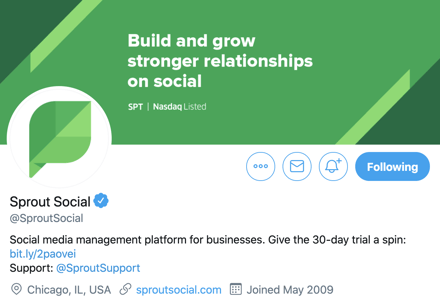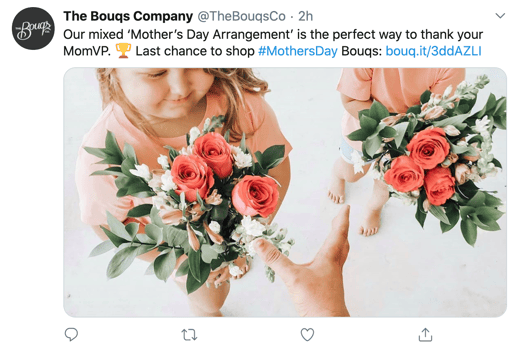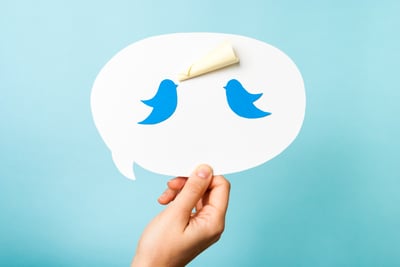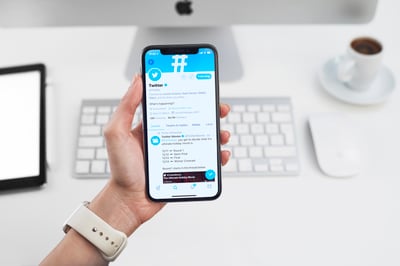September 10, 2018
 by Grace Pinegar / September 10, 2018
by Grace Pinegar / September 10, 2018

If you still think Twitter is nothing more than a meme playground, you’ve fallen behind on the times.
Twitter is a multi-dimensional platform that serves as a respected news source, a network to connect with verified public figures and celebrities, and a community of shared sorrows and celebrations, to name few of its popular uses.
Like other social media platforms, Twitter has become a leading channel for businesses to market their offerings. With hundreds of millions of users scrolling their newsfeeds on a daily basis, it makes sense that top brands aim to have an active presence on the site.
Wondering how to optimize your Twitter presence for effective marketing results? You may be surprised to learn you’re not alone. Many businesses are turning to Twitter to help reach a bigger audience, provide additional customer support to their users, and monitor their brand's reputation.
But how does it all work? Let's break down everything there is to know about effectively marketing your business on Twitter.
If you're familiar with social media marketing, then you know that developing an effective strategy on a new platform takes time. It's not as simple as using your Facebook marketing plan and trying to replicate it on Twitter. Users on the Twitter platform have entirely different expectations for the type of content they want to see from the brands they follow.
With that in mind, there are a handful of Twitter marketing best practices that can help get you started on the right foot.
As you would with any new marketing initiative, the first step is to establish clear goals and objectives. It's important to nail down the "why" behind your efforts. Growing a social media following on a new platform will require time and resources, you need to be able to clearly communicate why this project is worth it.
Here are some examples of realistic goals your business can achieve through Twitter marketing:
It may help to do some research on your competitors or campaigns run by other brands to help shape your own strategy.
Your goals should also be reasonable. Unless your business is already a top global brand, you probably won’t be able to accumulate millions of followers overnight. While you’re encouraged to challenge yourself, your goals should still be to scale within the current scope of your team's abilities. This is where an analysis of competitor data can come in handy - it may help you identify better, more realistic goals that are still actionable.
Once you’ve developed your goals, it’s time to jump into action and create a branded profile for your company. If you're familiar with how to use Twitter, you probably know by now that the process of setting up an account is quick, easy, and best of all - free.
After your account set up is complete, the next steps are to optimize your profile to be engaging. Here's how:

Source: Twitter
For the profile photo, most brands use their logo since it's simple and recognizable. When deciding on a banner image, consider using a graphic that is sleek, on-brand, and eye-catching. Some companies will switch out the banner image periodically to promote upcoming events or deals.
The perfect Twitter header size is 1500 x 500 px. The safe area is 1500 x 360 px, with a profile picture size of 400 x 400 px. The maximum file size is 2MB, and the accepted formats are JPEG and PNG files.
Your Twitter bio is the small but mighty blurb at the top of your page that give audiences a 3-second insight into who you are as an organization. Many brands use this space to highlight a current promotion or simply include their company slogan. Your bio should include a link to your website’s home page or whichever landing page you want to point visitors to.

Source: Twitter
Your bio should follow the tone of your overarching brand voice. If your page is funny, make your bio quippy. If your page seeks to be informative, make the bio fact-focused.
As with any customer-facing marketing channel, it's important to develop a set of brand guidelines that you and your social media team can follow. These guidelines will ensure that no matter who is tweeting, the responses are consistent according to the predetermined regulations.
The tone will change depending on what kind of Twitter profile you’re running. Some brands have a separate Twitter for customer service and technical support, while other brands operate completely out of one profile. The type of profile will determine the brand guidelines, so make sure you’ve fleshed those details out with the profile’s purpose in mind.
Tone continuity is important because you have an audience on the other side. If you’re a fairly serious law firm whose dealings are mostly divorce and estate separation, your tweets probably shouldn’t be sarcastic. Your network is expecting that you take matters seriously and can handle heavy subject matter professionally.
Now begins the fun part. On Twitter, short-form content reigns supreme. After all, that's how the platform is designed - you’re limited to 260 characters. Your tweets should be designed to create intrigue and show off your brand's personality. If you want to promote long-form content, pull readers in with concise, engaging copy and provide them with a link to take them to another web page.
Plan on tweeting regularly. In the same way that it's off-putting to see a profile with no followers, it's also off-putting to see a profile with no tweets. Users want to follow accounts that are actively churning out fresh content.
While you don’t have to tweet at the same time every day, you should be tweeting at least once a day. There should be a consistent strategy in place that engages users at peak hours. This keeps your business relevant by showing up in your followers’ feeds on a regular basis.
Tip: Finding the time to post on Twitter every day can be difficult. Social media management software can help you schedule out tweets beforehand to ensure you're posting on a regular cadence without the hassle of having to do it yourself.
As mentioned previously, always keep your brand voice in mind and communicate using language that's similar across all of your marketing channels. If your tone is not sarcastic or witty on other profiles, it would be strange to take up that style on this new platform. To users, it may feel like the account is disingenuous or illegitimate.
One professional draw of Twitter is how up close and personal it places you with your audience. You have the ability to interact on a personal level with people who could become loyal customers or network with like-minded business owners.
A few ways to utilize your Twitter profile to its full potential are to continually reach out to others. Jump into conversations or Twitter threads you find interesting and relevant. Don’t be afraid to ask people to follow you back or retweet your content; especially if the content is relevant to their followers’ interests.

Source: Twitter
Aim to "like" other tweets that you find compelling, as the simple act of receiving a notification could lead people to check out your profile, peruse your product, or follow you back.
When it comes to engaging with other accounts, it’s important to note that who you follow could jeopardize your reputation. For example, if you’re not running a politically-affiliated profile, there’s no reason to follow certain candidates or profiles otherwise associated with the causes they support. This could be seen as a conflict of interest. Additionally, you probably don’t want to lose followers over liking or retweeting something that your followers might find offensive or distasteful.
Regardless of the decisions you make in who or what to support, just be aware that these decisions can have an impact on your business.
A Twitter List is a feature that allows users to add a group of other Twitter accounts into a single list. This is another organizational tool, similar to how hashtags briefly denote what a tweet is about.
Lists are like a group message, but for tweets. You, as the Twitter user, create lists based on what you are interested in. Say that’s ice cream. You want to have a separate feed that only consists on tweets about ice cream. So you find the top 20 users whose content you want to see on this list and add them to it. Now when you want to know what’s going on in the world of ice cream, all you have to do is navigate over to that list and view all the updates from the users you selected.
Twenty is a sample number, but lists can feature up to 5,000 users. Lists can be public or private, depending on who you’d like to see that list, and who you’d like to see that you created the list.
Lists are good for your business because they allow you to sort by competitors, partner companies, industry leaders, etc. Since your main news feed is essentially a series of randomized posts, viewing your Twitter network through differentiated lists is a good way to make sure you don’t miss anything.
Social media is known for its ability to connect people around the world to the same topic. Hence, the creation of the hashtag. Hashtags are the “#” sign you see in front of words or phrases that serve to summarize what the tweet is about.
Hashtags are a sort of organizational strategy. They help users say, “these are my interests, this is what I’m talking about.” As a business, you should take advantage of using and viewing hashtags.

Source: Twitter
To start using hashtags, you need to do some preliminary research to see what tags are associated with your industry. Related tags could be anything regarding an upcoming national holiday, to words or phrases that relate to your business. It’s not a perfect science — there is no one monitoring hashtag usage, so anyone can put anything on any post. This leaves a lot of posts with unrelated hashtags. But if you’re stumped on where to look to grow your following from the ground up, hashtags are a great place to start.
It’s imperative that your Twitter marketing strategy integrate or be consistent with your marketing efforts on other platforms or within alternate solutions. For example, if you have an email marketing newsletter, include links to your social media pages as part of your email signature.
It's a good idea to cross-promote your content across all of your social media accounts to ensure you get as many eyes on it as possible. Just remember that what might be working for your brand on Twitter won't necessarily translate to the same success on Facebook. Different social media networks have different audiences with differing expectations for the type of content they want to consume.
Social listening is essential to maintaining a positive brand reputation. Twitter is a popular outlet for users to discuss things they like or dislike about brands and express customer service concerns. For marketers, this is a tremendous opportunity to elicit real-time feedback from your audience and keep a pulse on public perception of your brand.
We can apply this same idea of social listening when it comes to understanding how your competitors are doing. Even if you don’t directly follow your competitors, it's a good idea to keep an eye on what they’re posting to identify opportunities where you can outperform them.
Want to go bigger? Also keep track of the brands you’d like to compete with. Taking tips from brands with much larger budgets and teams will inspire you to go beyond your present circumstances and instead dream of all that could be possible.
Marketing efforts mean nothing if you have no strategy in place for monitoring progress. Lucky for you, there are all kinds of ways to figure out not only how your content is doing, but also who is taking notice of your brand on social media.
Twitter Analytics is a free built-in tool that comes with every Twitter account. The feature allows you to view tweet activity, number of impressions, and detailed audience data such as demographics and behavioral insights. It's a good idea to keep a close eye on your Analytics page to assess how your Twitter content is performing and make adjustments accordingly.

Source: Twitter
Knowing which metrics to track is essential to effectively monitoring your progress. Here are the most important metrics you should focus on:
Depending on your marketing goals, some metrics might carry more weight than others. For example, if Twitter is a primary channel for answering customer service inquiries, then looking at number of mentions is probably more important to you.
If you’re advertising on any social media platform, you need to have a reporting strategy in place. Without it, you’ll surely miss out on opportunities to improve your content and grow your following.
Tip: If you promote your brand on multiple channels, it's a good idea to consider investing in social media monitoring software. This type of solution allows you to track and gather relevant data across multiple platforms.
Twitter is a great way to connect with your peers, customers, and colleagues. At the end of the day, that’s why we log on to these sites - to experience human connection through a digital resource. So long as your brand caters to who your customers are as people, with relevant and engaging content, your marketing strategy should take off.
Want to take your Twitter marketing strategy to the next level with paid advertising? Learn everything you need to know about Twitter Ads before taking the plunge.
Grace Pinegar is a lifelong storyteller with an extensive background in various forms such as acting, journalism, improv, research, and content marketing. She was raised in Texas, educated in Missouri, worked in Chicago, and is now a proud New Yorker. (she/her/hers)
Twitter has come a long way since its launch back in March 2006.
 by Scott Julio
by Scott Julio
With an average of 265 million monthly users, Twitter is, hands-down, the platform to leverage...
 by Archita Sharma
by Archita Sharma
Stop sitting on the sidelines and get in the Twitter chat game!
 by Lauren Pope
by Lauren Pope
Twitter has come a long way since its launch back in March 2006.
 by Scott Julio
by Scott Julio
With an average of 265 million monthly users, Twitter is, hands-down, the platform to leverage...
 by Archita Sharma
by Archita Sharma


